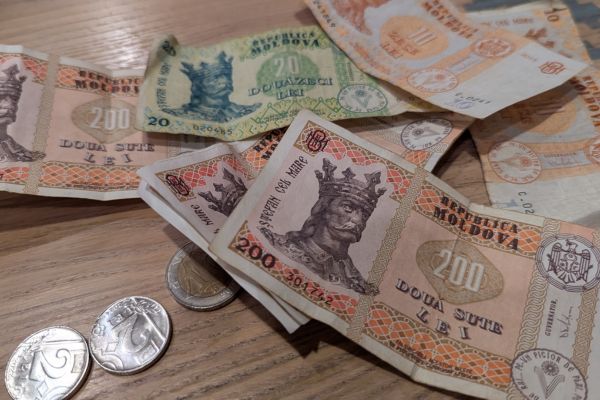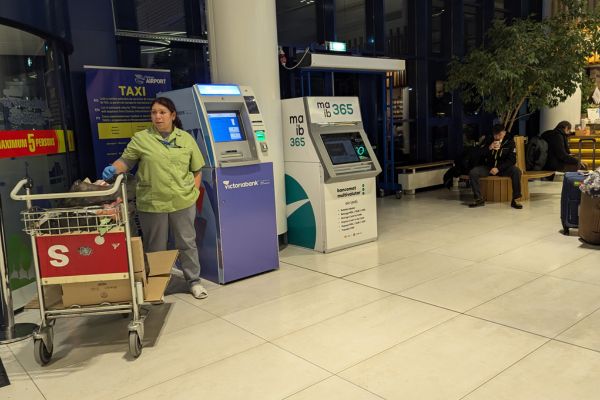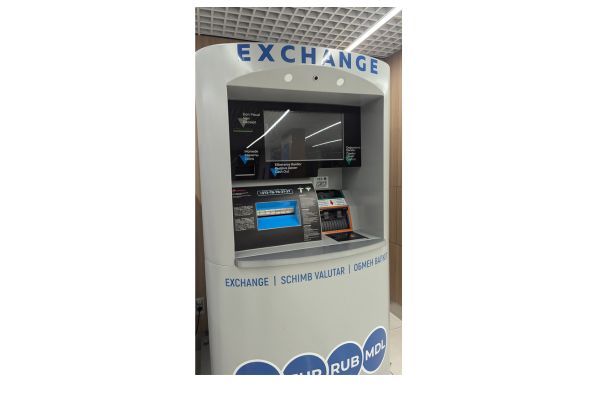Traveling in Moldova is affordable and straightforward, but like anywhere, it pays to understand how money works before you arrive. My guide walks you through Moldovan ATMs, bank fees, local currency, and the best ways to use your debit and credit cards. I’ll share what I learned on my trips here—everything from ATM withdrawal quirks and airport exchange traps to avoiding unnecessary charges.
I’ve also pulled together a table with the fees and withdrawal limits at Moldova’s main banks, so you know what to expect before you insert your card. You’ll find tips on paying in Moldova, how to stretch your budget, and what the Moldovan leu actually looks like in your hand.
THIS POST MAY CONTAIN COMPENSATED AND AFFILIATE LINKS MORE INFORMATION IN OUR DISCLAIMER
This is community-driven content, so if you’ve had a different experience at a Moldovan ATM, or spotted a change in bank fees, please drop me a comment or email me at sarah @ asocialnomad.com—let’s help each other keep this info up to date.
Moldova Money at a Glance
- Currency: Moldovan Leu (MDL), 1 leu = 100 bani
- Coins: 1, 2, 5, 10, 50 bani; 1, 2, 5, 10 lei
- Notes: 1, 5, 10, 20, 50, 100, 200, 500 lei
- Cash vs Cards: Cash dominates outside Chişinău; cards fine in supermarkets, hotels, and big restaurants
- ATM Fees: 1.5–2.5% + 20–50 MDL depending on bank
- Withdrawal Limits: Typically 2,000–5,000 MDL per transaction
- Best Strategy: Use a no-foreign-fee card, withdraw max amounts, always select to be charged in lei
- Currency Exchange: Widely available at kiosks in cities; avoid airport desks for large sums
PRACTICAL TRAVEL TIPS
- 🛡️ Get Travel Insurance: Civitatis includes medical expenses, repatriation, theft, luggage delays. No deductibles or upfront payments. Get a quote here.
- 💰 Read about the Currency in Moldova and ATM fees.
- 🔌 Check out Moldova’s plug, socket & power situation.
- 📶 Internet, maps and data on the go. eSims for Moldova
Paying for things in Moldova
In Moldova, you’ll need either a card (debit or credit) or cash to pay for things. And when I say cash, I mean Euros or Moldovan lei (MDL), which is the country’s official currency. If you’re paying for things like hotels or tour guides you should check ahead of time, but they’re likely to accept Euros as well as MDL.
If you’re arriving at the airport with no MDL, then your taxi driver will accept Euros, Romanian Leu and possible US Dollars. Confirm before you get in the car. Or take a transfer.
You can read my guide on getting from the airport to Chisinau here to see what your options are.
Cards are becoming more widely accepted, especially in Chişinău, at supermarkets, restaurants, and larger hotels. Depending on where you’re staying, you should check WHEN YOU MAKE YOUR BOOKING how you will be required to make your payment. We paid cash, in Euros for our hotel in the center of Chişinău.
You’ll also find online payments useful if you want to prebook transport, tours, or accommodation. But don’t expect contactless everywhere—while some bigger places have it, most places that accept cards still have terminals still require you to insert your card and enter a PIN.
Even before you get outside the capital, cash is essential. Want to go to a museum? You’ll need cash. Heading to the markets, using marshrutkas (minibuses), eating in smaller cafés, and taxis usually only take cash, and drivers will expect exact change if possible. Yes, even in Chişinău, some cafés or taxis are still “cash only.” Here’s my guide of what to do in Chisinau.
#1 TIP FOR CASH & CARDS
Get a WISE Card to take to on your travels. Two free ATM withdrawals per month, plus free to use to pay by card with zero foreign transaction fees.
Moldovan Currency – The Leu (MDL)
Moldova uses the leu (plural: lei), written as MDL. It’s a closed currency, which means you can only get it inside Moldova—you won’t find it at your local exchange counter before you travel.
The leu is divided into 100 bani. (the same as the Romanian leu) Coins come in 1, 2, 5, and 10 bani, plus 50 bani and 1, 2, 5, and 10 lei. Notes are 1, 5, 10, 20, 50, 100, 200, and 500 lei. The smaller notes (1, 5, 10) are often quite worn, while the larger bills are much newer and harder to break, so try to hold on to small notes for marshrutkas, market purchases, and tips.

If you head into Transnistria, then the currency is different again. Read my guide to Transnistria here.
Cash versus Cards in Moldova
Moldova is still very much a cash-first country. If you’re taking a marshrutka, paying at the central market, or tipping a guide, cash is the only option. Small towns and villages outside Chişinău are almost entirely cash-based, and even local guesthouses will often prefer payment in lei. If you’re visiting Orhei (and you should), then the restaurant at Butuceni takes cards. Check out their menu and my guide to Orhei here.
We used our cards for ALL the restaurants we ate at in Moldova. There’s more on what to eat and some great restaurants to eat at in my guide to Moldovan food and drink here.
You’ll have no problem using a debit or credit card at larger supermarkets, shopping malls, restaurants, and larger hotels. International booking sites also make it easy to pay for tours and transfers online, which saves you the hassle of withdrawing large amounts of cash.
But—and it’s a big but—don’t assume you can get by without cash. Outside of the city, aside from the larger wineries, where you can pay with a card, assume it’s cash only.
The good bit? There are ATMs at the airport. They work and don’t charge exorbitant fees. And yes there are ATMs to be found once you get into Chişinău too.

Tips for Minimizing ATM & Card Fees in Moldova
Withdrawing cash in Moldova is simple enough, but the fees can sneak up on you if you’re not careful. ALL MOLDOVAN banks charge a flat fee for foreign cards, and the rates vary a LOT. You can also withdraw Euros, US Dollars and Romanian Leu in many ATMs in Moldova, but those fees are higher.

ATMs in Moldova usually offer instructions in Romanian, Russian, and English. Visa and Mastercard are widely accepted; American Express is much less so.
To keep your costs down:
- Fees tend to be a percentage of what you’re taking out, so don’t max out your limits if you’re going to need to convert it back after your trip.
- Use a card with zero foreign transaction fees. Cards like Wise, Starling Bank (UK), or Charles Schwab (US) can save you a bundle.
- Prepay online when you can. Day trips to Cricova or Orheiul Vechi, or even transfers from the airport, can be booked and paid in advance on reputable platforms like GetYourGuide or Viator.
- Always choose to be charged in lei. ATMs sometimes prompt you to pay in your home currency—this is Dynamic Currency Conversion (DCC), and it always costs you more.
- Carry a backup card. It’s not unusual for one bank’s ATM to reject a card while another accepts it.
- Keep your receipts. Some US banks reimburse ATM fees if you can prove the charge.
- In Moldova not every ATM flashes up the fee before you accept—it’s often just deducted. So if you’re testing a new bank’s machine, keep your withdrawal small until you know what they’ll charge.
Currency Exchange Options in Moldova
Exchanging money in Moldova is easy—you’ll see currency exchange kiosks everywhere, especially in Chişinău. They’re usually marked with boards outside listing the current rates, and most are legitimate. Rates are generally decent, but you’ll often get a slightly better deal withdrawing from an ATM if your card has no foreign fees.
Airports, of course, are the exception. Chişinău International has exchange desks, but the rates are noticeably worse. If you land with no lei, change only a small amount at the airport—just enough to cover a taxi or bus, or use the ATMs that you’ll find JUST by the exits.
Hotels and guesthouses will sometimes offer exchange too, though the rates are rarely in your favor. Banks can exchange foreign currency as well, but opening hours are shorter, and you’ll often have to queue.
For maximum value:
- Stick to ATMs from the major Moldovan banks.
- Use a no-fee card for withdrawals.
- Carry some small Euro or Romanian Leu notes as a backup—these are easily exchanged in Chişinău if you get caught short.
ATM Provider Table – Moldova
| ATM Provider | Typical Withdrawal Limit | Observed Fees | Notes | Date of Information |
| MAIB (Moldova Agroindbank) | 3,000–5,000 MDL | 1.5% + 20 MDL (~1.05 EUR) | Big network, lots of ATMs in Chişinău, English instructions available | November 2024 |
| Victoriabank | 3,000–5,000 MDL | 1.5% + 20 MDL (outside hotels) / 2.5% + 20 MDL (inside hotels) | Relatively big network, Visa & Mastercard accepted, sometimes asks DCC | November 2024 |
| Moldindconbank | 2,000–3,000 MDL | 2% | Big network, plenty of ATMs in Chişinău as well as towns | November 2024 |
| OTP Bank | 3,000–4,000 MDL | 1.5% + 1 EUR | Big network, especially in Chişinău | 2024 |
| FinComBank | 2,000 MDL | 2.5% + 50 MDL (~2.60 EUR) | Rather small network, fewer ATMs | November 2024 |
| Energbank | 2,000–3,000 MDL (≈400 EUR/day) | 2.5% | Few ATMs in Chişinău | November 2024 |
Airport ATMs & Chişinău Spending
Chişinău International Airport has a handful of ATMs near arrivals, and they’re handy if you need lei straight away for a taxi or bus into the city. Withdrawal limits are similar—usually around 3,000–5,000 MDL—but don’t expect every bank to have an ATM in the airport.
Currency exchange desks are also available at the airport, though their rates are poor compared to the exchange kiosks you’ll find in central Chişinău. If you need cash urgently, change just enough at the airport to get you into the city and sort the rest once you arrive.
MOLDOVA TRAVEL RESOURCES
AIRPORT TRANSFERS
24/7 pickup & drop off. Trusted, local English speaking drivers. Prebook & prepay online with cards.
Book a Transfer
HOTELS AND APARTMENTS
See choices here
Rooms with a view? Budget rooms? Need a washing machine? The best choice of hotels & apartments.
TOURS & ATTRACTIONS
Most excursion choices, small group tours, skip-line tickets, free cancellation and top local guides.
Top options here.
CAR RENTAL OPTIONS
Choose cars here
Best choice of vehicles, automatics, large or small cars, child seats. Book early for more options.
Final Words on Currency and ATM fees in Moldova
Moldova is still a country where cash rules daily life. In Chişinău, you’ll be able to use your card for hotels, supermarkets, and restaurants, but once you step outside the capital, lei in your pocket is essential. Marshrutkas, local markets, taxis, and even some cafés are cash-only, and it’s always easier if you have smaller notes.
ASocialNomad is a participant in the Amazon Services LLC Associates Program, an affiliate advertising program designed to provide a means for sites to earn advertising fees by advertising and linking to amazon.com, amazon.co.uk, and amazon.ca. Amazon and the Amazon logo are trademarks of Amazon.com, Inc. or its affiliates. As an Amazon Associate, I earn from qualifying purchases.


